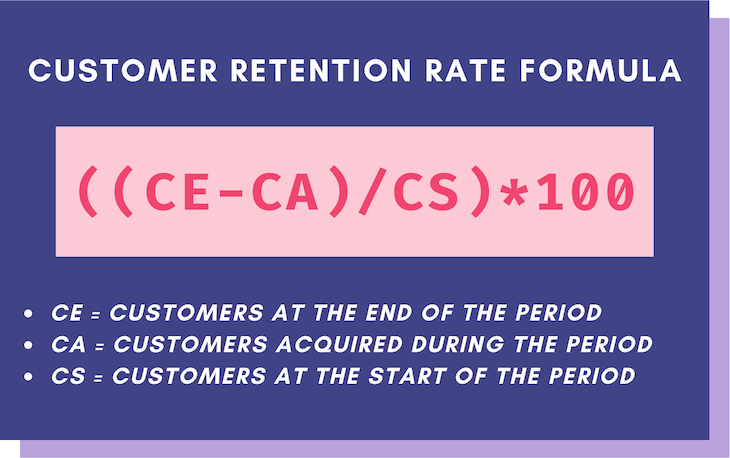Retention rate is a metric to measure the percentage of customers who continue to use a product or service within a specified period. While many product managers focus on quickly gaining new customers, it doesn’t do much for overall business growth if customers as quickly leave it.
Simply offering an excellent product is usually not enough to gain new customers and retain existing ones. Other factors, such as customer support, UX design, and competitors, may affect your ability to have a high retention rate.
Keep reading to learn what retention rate means, how to calculate it, and a few tips on how to increase your retention rate.
Table of contents
- What is customer retention rate?
- Why is retention rate important?
- How to calculate retention rate
- What product metrics impact customer retention?
- What is a good retention rate?
- How to improve retention rate (with examples)
What is customer retention rate?
Retention rate is a crucial product metric that can dictate a company’s growth and profitability. A high retention rate means that customers continue to use the product and typically goes hand-in-hand with a high acquisition rate. The combination of good retention and consistently bringing in new customers means the company moves to an overall growth trajectory.
Retention rate is different from churn rate (also known as attrition rate). While the retention rate tracks users who continue to use the product, churning refers to the rate at which users stop using the product.
Retention and churn are closely related and affect each other. For example, a high churn rate indicates a low retention rate.
Why is retention rate important?
Ultimately, every company wants to increase its revenue. Measuring retention aids in the pursuit of revenue.
But retention rate does more than track and predict a company’s revenue. It can also help a company track other factors, including:
- Customer loyalty
- Customer satisfaction
- Product value
- Product profitability
Because every product aims to bring in and retain customers, product managers need to understand what keeps customers using the product and also what drives them away. Retention rate is a significant metric to determine whether a product is resonating with customers.
While losing some customers is inevitable, product managers need to determine a baseline retention rate. Once you figure out where your customers currently stand, you can start to make goals to improve retention.
How to calculate retention rate
Let’s start with an overview of the basic retention rate calculation.
First, you’ll need to choose a time frame. This could be anywhere from 30 days to a year, but you’ll want to pick a time frame relevant to your evaluation.
Then, take the following steps to determine the retention rate:
- Take the number of customers at the end of the time frame and subtract the number of customers gained within the time frame
- Divide the resultant figure by the number of customers at the beginning of the period
- Multiply by 100 to get a percentage

How to calculate churn rate
Calculating the retention rate will also produce the churn rate.
For example, if your retention rate is 90 percent, then your churn rate is 10 percent. The churn rate is simply the inverse of your retention rate.
However, this type of retention rate doesn’t offer the full picture. Let’s take a look at the churn rate.
Some companies may consider a cancellation at the end of a trial period as churning even though it doesn’t directly impact revenue. In others, only actions that impact revenue qualify as churn. Product managers must decide what events count as churn and retention.
What product metrics impact customer retention?
The retention rate shows you what is happening, but not why it’s happening. Product managers will also need to evaluate other metrics to understand the subtle differences that may cause some customers to leave and others to stay.
Here are a few other customer retention metrics you should consider evaluating:
- Cross-sell and upsell
- Positive insights
- Cohort analysis
- Retention rates based on time
- Revenue churn
- Net Promoter Score (NPS)
- Repeat purchase rate
- Customer lifetime value (CLV)
Cross-sell and upsell
You may want to evaluate whether existing customers took offers with cross-selling and upsells. This is an important part of expanding your company’s growth and revenue.
Positive insights
Product managers often focus on what causes churn and ignore what causes retention. By evaluating positive metrics, product managers can learn what positively impacted conversion and retention rates.
Cohort analysis
A cohort analysis creates groups with similar characteristics and analyzes their behavior. This can help you discover various interactions a cohort has with customer support and other product features.
Retention rates based on time
Another common mistake PMs make is to focus on user retention while neglecting to evaluate metrics based on time. A popular metric is the N-day retention rate (how many users are retained after a specific day from the time they signed up).
Revenue churn
Revenue churn tells you how much revenue your company lost in a given time frame. This is useful to provide context on how user churn may (or may not) be hurting your revenue.
The formula is to take the monthly recurring revenue (MRR) within a time frame and divide it by the MRR at the beginning of the time frame. Then, multiply by 100 to receive a percentage figure.
Net Promoter Score (NPS)
An NPS is usually a one-question survey asking a user how likely they are to recommend a product or service. This can help identify specific users who are not satisfied and then try to remedy their problems. It’s also useful to gauge overall customer satisfaction.
Repeat purchase rate
Repeat customers are people who buy more than once. This is a particularly important metric for e-commerce, retail, and restaurant companies.
You can calculate the repeat purchase rate by taking the number of repeat customers and dividing it by the total number of customers.
Customer lifetime value (CLV)
Product managers should know the customer lifetime value for different user segments and how much they contribute to the company’s bottom line through their product usage. Once you have a high CLV, you may be able to afford to spend more money and time on acquisition.
The most basic CLV formula is to take the average order value and divide it by the repeat purchase rate.
What is a good retention rate?
A large part of revenue is determined by customer retention. Depending on your product and industry, you’ll have different benchmarks for a successful retention rate.
There are also different methods to determine retention. For example, a B2B SaaS product will face different churn challenges compared to a B2C physical subscription box company.
You can measure retention rate against two benchmarks:
- Your past performance
- Your competitors’ performance
Retention analysis refers to comparing your current retention rate with past performance. This can help isolate the causes of what is causing it to go up or down.
If you measure yourself against your competitors, you’ll want to take a look at industry benchmarks to determine how your product is faring against trends.
How to improve retention rate (with examples)
A period of decline is every company’s worst nightmare, but it does happen. Fortunately, there are ways to manage product decline. It’s often advisable to take the pivot approach, which may mean entering a new market or re-engaging inactive users.
Netflix is a prime example of a company that successfully managed a decline period. Long the reigning champion of streaming services, it found itself with fierce competition and, subsequently, declining subscriptions.
Netflix elected to pivot and enter a new market. It’s currently in the process of adding a new subscription tier that will offer a cheaper rate with ad-supported streaming. The goal is to re-engage previous subscribers with an affordable subscription and also maintain their current customer base.
Gaining new customers is often more expensive than retaining existing customers. So while marketing to potential customers is an important part of growing your business, don’t neglect your current customer base. Your current customers are a gold mine for valuable feedback on what does and doesn’t work for them. By injecting customer feedback into your retention strategy, you may find ways to improve the user experience.
SaaS companies especially may also want to consider investing in analytics software with session replay and performance monitoring features. This is a valuable tool to determine whether UX design, customer support, or other factors are causing users to stay as customers or cancel their subscriptions.
Conclusion
Retention rates are valuable for showing how the overall business is performing, but it’s important for product managers to evaluate other metrics and factors to learn the causes of retention and churn.
With a strong retention evaluation and strategy, product managers can help their customers connect to company products and enjoy continuous value.
The post What is customer retention rate and how to calculate it appeared first on LogRocket Blog.
from LogRocket Blog https://ift.tt/gDCmvxr
Gain $200 in a week
via Read more



